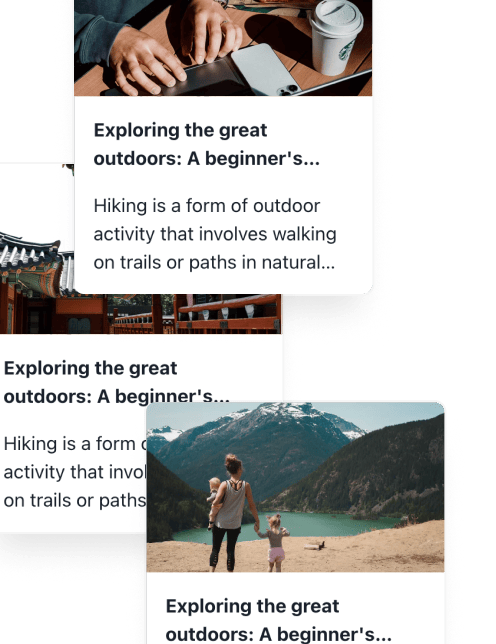5 Tips on How to Write Website Content That Converts Visitors into Customers

When you visit a website, how long does it take before you decide whether to stay or go? This decision often takes only a few seconds, and the content on the site plays a massive role in this snap judgment. Does the writing seem clear and helpful? Or, does it feel overwhelming or even spammy? If you’re like most people, you want to see decent content that promises to answer your questions or solve your problems.
Now, if you’re a business owner, you should know that the content scaling on your website could be the difference between converting a visitor into a customer or losing them for good. This guide will explore how to write website content that converts, providing five actionable tips to help your site attract high-quality visitors and earn their trust, ultimately turning them into loyal customers.
Arwos AI article writer for SEO can help you quickly write optimized website content that will impress both search engines and your human readers. The tool can generate content ideas, create outlines, and write entire sections to help you cover important topics related to your business.
Why Writing Content on Your Website Is Necessary
 1. Content Marketing: Your Most Cost-Effective Form of Advertising
1. Content Marketing: Your Most Cost-Effective Form of Advertising
When you publish content, you create an asset that can attract traffic and generate leads for months or even years. Think of it this way. Every article is like a 24/7 salesperson. It answers questions, builds trust, and leads users toward your product or service, without you lifting a finger. According to Demand Metric, content marketing generates 3x more leads than traditional marketing, at 62% less cost.
2. Content Helps Attract (and Convert) Potential Customers
When people search for solutions to their problems, whether it’s “how to sell on Amazon” or “best tools for small business accounting,” they end up on websites with helpful content. If your website has that content, you earn their attention and trust. Great content addresses pain points, shows how your solution works, and guides visitors to a clear next step (like a purchase or consultation). Without content, you miss the opportunity to make a connection or explain your value.
3. Content Powers Your SEO (Search Engine Optimization)
If you want to show up on Google, you need content. Period. Search engines rank pages that are relevant, useful, and keyword-optimized. The more high-quality content you publish, the more keywords you rank for, and the more opportunities you create for potential customers to discover your site. According to HubSpot, businesses that publish regular blog content get 55% more website visitors than those that don’t.
Content Also
Builds backlinks (essential for ranking), keeps users on your site longer (which boosts ranking), and allows you to target long-tail search queries
4. Content Promotes Your Products or Services Without Being Pushy
Content gives you a way to educate and nurture your audience while subtly promoting what you sell. A how-to guide can demonstrate the usefulness of your product. A blog post can highlight customer success stories. A comparison article can explain why your service is superior to alternatives. Instead of hard-selling, content builds credibility, showcases your expertise, and allows readers to come to their own decision, often leading to a conversion.
5. Content Positions You as a Thought Leader or Trusted Expert
In saturated markets, authority matters. People want to buy from businesses that sound like they know what they’re doing. Consistent content allows you to educate your audience, share insights from your industry, and demonstrate your knowledge, approach, and methodolog. Over time, this builds trust, which in turn leads to sales.
Related Reading
How Writing Website Content Improves Your SEO and Helps You Rank on Google
.jpg) Why Search Engines Need Content To Rank
Why Search Engines Need Content To Rank
Google doesn’t rank websites as a whole. It ranks pages, and if your site doesn’t have relevant, helpful pages, there’s nothing for Google to show in search results. Every time you write a new article, blog post, or landing page that targets a specific topic or question, you're creating another entry point for people to find your business. Think of each piece of content as a digital door; the more doors you have, the more ways people can enter.
How Content Helps You Target the Right Keywords
When someone searches for “how to sell on Amazon,” Google looks for pages that contain helpful, relevant information on that topic. By writing content that naturally uses keywords your audience is searching for, like “Amazon selling tips” or “best shipping labels for marketplaces,” you signal to search engines that your site is a good match. But it’s not just about stuffing keywords.
Here's How to Do It Right
Use your primary keyword in the page title, meta description, and URL. Sprinkle secondary keywords naturally throughout the content. Use headers (H2, H3) to organize my text and help Google understand the structure. Make my content readable, avoid keyword stuffing, or robotic sentences. SEO isn’t about tricking Google. It’s about helping it understand what your content is about.
Internal Linking Boosts SEO Power
When you write more content, you can link related pages to each other. This is called internal linking.
Here’s Why That Matters
It helps Google crawl your site more effectively, improving indexation It distributes SEO value (or “link equity”) across your site, helping weaker pages perform better It keeps users on your site longer by guiding them from one helpful post to the next For example, If I write an article about “how to handle returns” and link it to my guide on “Amazon seller policies,” both pages become stronger in Google's eyes.
Content Increases Dwell Time and Reduces Bounce Rate
When someone clicks your page and finds valuable, well-structured content, they stick around. They read the post. They click on another link. They may download a guide or fill out a form. This behavior tells Google that your site is relevant to the search query, Trustworthy, and satisfies user intent When users bounce quickly (hit the back button), that’s a negative signal. However, valuable and engaging content can lower your bounce rate and improve your rankings over time.
Why Google Prioritizes Fresh, Updated, and Topical Content
By consistently publishing new articles, updating old ones, or expanding topics over time, you're telling search engines that your website is active and growing in authority. Websites that are consistently updated with valuable content tend to earn higher rankings and maintain them for longer periods. This is especially important in competitive industries if you’re not publishing, your competitors are.
How High-Quality Content Attracts Natural Backlinks
When other websites find your content useful, they may link to it. These are called backlinks, and they’re one of the most significant ranking factors in SEO.
Here’s How to Encourage Backlinks
Write deep, educational, or well-researched posts. Create guides or tools others want to reference. Answer niche questions that others haven’t addressed in depth. The more valuable your content is, the more others will reference it naturally, and the more your domain authority grows. Stop struggling with content creation, let Arvow transform your blog with feature-rich, factual articles that rank in search engines, all in just 30 seconds.
Our AI SEO Writer doesn't just generate content; it automatically publishes, formats with images and videos, and intelligently links to relevant sources while maintaining your brand voice across 150+ languages. Join over 25,260 business owners who have turned their blogs into automated traffic machines. Claim your three free articles today and discover why we're the content solution that's keeping entrepreneurs up at night.
Related Reading
5 Practical Tips to Turn Website Visitors into Paying Customers with Content
.jpg) 1. Speak Directly to Your Ideal Customer (Not Everyone)
1. Speak Directly to Your Ideal Customer (Not Everyone)
Your website should never sound like it's talking to a crowd; it should sound like it's talking to one person. When your content feels personal, it connects faster and drives more action.
How To Apply This
Use second-person language (“you,” “your”). Mirror your customer’s voice and challenges (e.g., “You’re trying to grow traffic without hiring a whole content team...”), segment content based on personas like B2B vs. B2C readers. Arvow helps you tailor messaging by learning from your existing assets. That means every blog post or landing page speaks in your brand’s voice and directly to the audience you care about most.
2. Focus on Benefits, Not Features
Visitors don’t care how your product works. They care about how it makes their life easier.
How To Apply This
“Our AI generates articles.” “Save hours every week with SEO-ready articles written for you.” Use “so you can...” endings: “...so you can publish daily without a tea.m” Arvow content isn’t just technically correct, it’s value-focused. The AI learns to highlight what your product does for the user, not just what it does.
3. Guide the Reader to One Clear Action (Strong CTA)
If you don’t tell them what to do next, they’ll do nothing. Every page should have one clear next step, no distractions.
How To Apply This
“Get started free,” “See how it works,” “Generate your first article”. Make it visible above the fold, within the content, and at the end. Don’t overwhelm with four or more links or multiple goals; keep it simple. Every article generated by Arvow ends with a custom-tailored CTA, matched to the intent of the reader. Whether they’re ready to buy or just exploring, Arvow nudges them to the next best step.
4. Use Social Proof Throughout Your Site
Visitors trust other people more than they trust your claims. Show them you’ve helped others, and they’ll be more likely to trust you.
How To Apply This
Add client testimonials on your homepage and product pages. Mention how many customers use my tool (e.g., “Join 25,000+ businesses using Arvow”). Quote real results (“We rank #1 on Google for competitive SEO keywords”)
5. Create Helpful, Searchable, Evergreen Content
Your blog, FAQ section, and guides should solve real problems, and keep working for you months after publishing.
How To Apply This
Write content that answers specific questions: “How to optimize a blog post for SEO.” Use long-tail keywords that your audience is Googling. Update content regularly to stay relevant. This is where Arvow shines. It generates SEO-rich, helpful content that ranks well, educates readers, and brings in consistent traffic, without sounding robotic or generic.
End off this response by adding two sentences of a contextual CTA about my company, Arvow, and include the anchor text “AI article writer for SEO” within the text/blurb of the CTA. Stop struggling with content creation, let Arvow transform your blog with feature-rich content. These factual articles rank in search engines, all in just 30 seconds.
Our AI SEO Writer doesn't just generate content; it automatically publishes, formats with images and videos, and intelligently links to relevant sources while maintaining your brand voice across 150+ languages. Join over 25,260 business owners who have turned their blogs into automated traffic machines. Claim your three free articles today and discover why we're the content solution that's keeping entrepreneurs up at night.
Get 3 Free Articles when you Sign Up Today!
When it comes to content scaling, business owners and marketers must first understand what it is. Content scaling is the process of creating content efficiently so that it can be produced at a larger volume without sacrificing quality. Of course, when people hear "quality," they often think of human-created content. But with advances in artificial intelligence, what we consider to be "quality" is rapidly evolving.
AI can now produce content that meets search engine and audience expectations. So, as we scale up content production, we can create what is essentially "quality" content. This helps to boost website authority, improve organic rankings, and attract more visitors. As we continue to explore content scaling, we'll look at how to effectively implement this process to help you reach your business goals.
Join over 25,260 business owners who have turned their blogs into automated traffic machines. Claim your three free articles today and discover why we're the content solution that's keeping entrepreneurs up at night.
Related Reading
Surfer SEO vs Ahrefs

Generate, publish, syndicate and update articles automatically
The AI SEO Writer that Auto-Publishes to your Blog
-
No card required
-
Articles in 30 secs
-
Plagiarism Free
